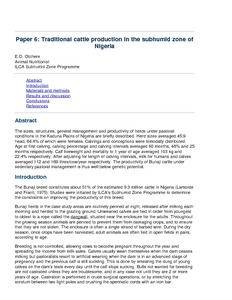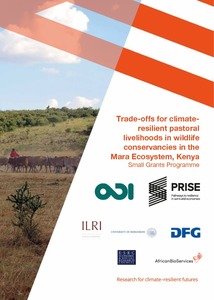Traditional African range management systems
Explains to what extent effective traditional African range management systems exist/existed, and discusses the factors which influence their incidence, persistence or effectiveness - focussing principally on sub-Saharan Africa.
Traditional cattle production in the subhumid zone of Nigeria
Describes, briefly, sizes structures, general management and productivity of pastoral herds in the Kaduna Plains of Nigeria. Includes data on age at first calving, calving percentage, calving intervals, calf liveweight & mortality to 1 year, and milk yield of Bunaji cattle under this sedentary pastoral management system. Identifies nutrition as cause of this below-genetic-potential productivity.
The Tribe - Platform of participatory local development and management of communal rangeland resources
Sustainable development of pastoral and agro-pastoral systems, dominated by collective and/or tribal ownership of rangelands, is a key issue for the West Asia and North Africa region. These two systems are located in arid and semi-arid areas and are increasingly threatened by desertification process. The policy responses to tackle this complexity have been a sectorial and fragmented, “top-down” approach, putting forward technical solutions and neglecting the social context.
Traditional livestock breeding practices of men and women Somali pastoralists: trait preferences and selection of breeding animals
Somalia, one of the world's poorest countries, has livestock as the mainstay of the economy, with an estimated 65% of the population engaged in the livestock sector. This paper presents a gendered study on the traditional livestock breeding practices of Somali pastoralists for camels, cattle, sheep and goats, with a focus on documenting livestock traits of importance, the criteria used to select male breeding animals and the criteria used to cull female breeding animals.
The use of herders' accounts to map livestock activities across agropastoral landscapes in Semi-Arid Africa
Improved understandings of the agricultural and range ecologies of semi-arid Africa require better information on the spatiotemporal distribution of domestic livestock across agropastoral landscapes. An empirical GIS-based approach was developed for estimating distributions of herded livestock across three agropastoral territories (around 100 km2 each) over a two-year period.
Training manual for pastoralists and agro-pastoralists on Index-Based Livestock Insurance
There are many futures for pastoralism in Africa
Adrian Cullis from FAO Ethiopia reflects on the recent conference in Addis Ababa on the future of pastoralism in Africa. The event's fundamental take home message is that "there is a future for pastoralism in Africa." However, it looks like there will be different futures and different forms of pastoralism - with winners and losers. He also outlines the work FAO does in this area, and comments on some issues like gender and productivity issues (of rangelands, of livestock) that received insufficient attention in the meeting.
Towards a framework for pastoral systems research
Describes the dif. phases in the ILCA research framework, w. regard to Livestock Systems Research (LSR), particularly the descriptive, diagnostic, design, testing & extension phases, using examples of field research on pastoral & agropastoral systems in the arid & semi arid zones of Mali, Ethiopia and Kenya.
Trade-offs for climate-resilient pastoral livelihoods in wildlife conservancies in the Mara Ecosystem, Kenya: Small Grants Programme
Transitions in agro-pastoralist systems of East Africa: Impacts on food security and poverty
Climate-induced livelihood transitions in the agricultural systems of Africa are increasingly likely. There is limited evidence on what such transitions might look like. We carried out fieldwork in 12 sites in Kenya, Tanzania and Uganda to understand changes in farming systems in the recent past, and to test the hypothesis that sedentary farmers in zones that may become warmer and drier in the future may be forced to increase their reliance on livestock vis-à-vis cropping in the future. We estimated the contribution of crop and livestock activities to incomes, food security and poverty.
Using Coupled Simulation Models to Link Pastoral Decision Making and Ecosystem Services
Historically, pastoral people were able to more freely use the services their semi-arid and arid ecosystems provide, and they adapted to changes in ways that improved their well-being. More recently, their ability to adapt has been constrained due to changes from within and from outside their communities. To compare possible responses by pastoral communities, we modeled ecosystem services and tied those services to decisions that people make at the household level.








